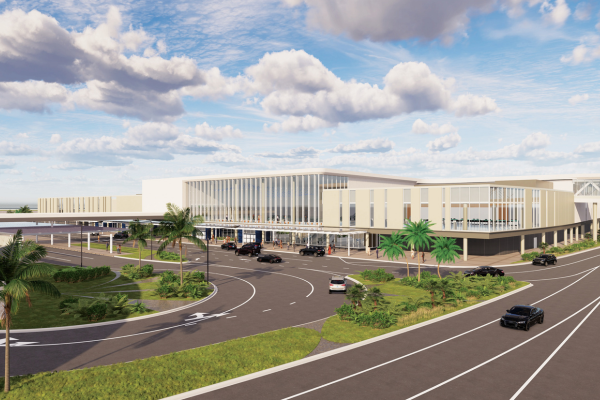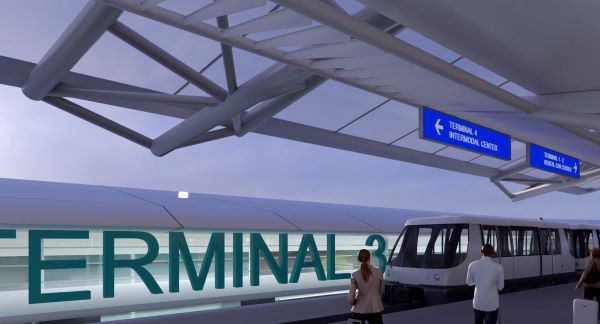Airport Developments
The Broward County Aviation Department (BCAD) is always striving to improve operations and the guest experience at the Fort Lauderdale-Hollywood International Airport (FLL).
For the latest updates on FLL projects, developments, and key events, check out the airport's monthly newsletter NewsFLLash.
Past copies of the newsletter and a link to subscribe to the publication can be found here.
Groundbreaking for new Terminal 5

Terminal 5 Exterior Rendering
BCAD, in conjunction with the Broward County Board of County Commissioners, hosted a groundbreaking ceremony for the airport's new Terminal 5 (T5) on October 9, 2023. The new two-level, five-gate domestic terminal will feature check-in/ticketing areas, arrival/departure baggage processing, a security screening checkpoint, retail, and food/beverage concessions. T5 will be approximately 230,000 square feet and will connect to Terminal 4 and the existing Cypress parking garage onsite through multi-level pedestrian bridges or walkways.
T5 will also have Americans with Disabilities Act (ADA) features similar to Terminals 1 through 4 and will have environmentally friendly elements built to Leadership in Energy and Environmental Design or LEED Silver certification standards.
JetBlue Airways Corp. is managing the construction on behalf of Broward County. As T5 project administrator, JetBlue hired Parsons in 2021 as Program Manager, M. Arthur Gensler & Associates (Gensler) in 2022 for design services, KEITH as Construction Engineer Inspector, and Hunt/Moss as Construction Manager at Risk in 2023. The multimillion-dollar state-of-the-art facility is anticipated to be completed by 2030.
Last Updated: May 28, 2025
Future Projects in the Pipeline
Terminal Connectors
The two new Terminal Connectors linking Terminals 1 and 2 and Terminals 2 and 3 will be game changers for FLL. Once completed, all terminals will be connected post-security, enabling passengers to move freely throughout the secured areas without exiting and re-entering a security checkpoint. In addition, connectivity among FLL’s four terminals improves exposure and access to airport concessions, wayfinding, and gate utilization flexibility to manage future growth more successfully. The estimated $260 million project is now targeted for completion in late 2027. For more information, click here.
Intermodal Center
BCAD completed advanced planning for the Intermodal Center (IMC) in 2022 and expects to start construction of the transportation hub within three to five years. The entire project completion (subject to regulatory and funding approvals) is projected for 2030. The proposed IMC for FLL would be a 4.6 million square foot, eight-level facility with approximately 6,685 vehicle parking spaces. The estimated $835 million IMC may have different uses and functions, such as multimodal opportunities, parking for airport, seaport, and transit passengers, a ground transportation center for commercial vehicle traffic, commercial center for revenue generation, and advanced air mobility operations on the top floor/roof. BCAD anticipates funding for FLL’s Automated People Mover (APM) and IMC to come from a combination of federal and state grants, possible local funds, and bonds supported by airport revenues, including passenger facility charges and airline fees.
Automated People Mover

(Note: The image above is for illustration purposes only and may not represent the final project design)
An Automated People Mover (APM) could become a reality at FLL over the next decade as part of the Aviation Department’s Master Plan Update and future vision for the airport. While currently in the advance-planning phase, BCAD is estimating the initial phase of the APM construction could begin within three to five years with full project completion (pending regulatory and funding approvals) by 2030.
As currently proposed, the APM circulator at FLL would consist of an elevated (60-65 feet above ground level) guideway and train system connecting the airport’s terminals, existing parking garages, Rental Car Center, and the future Intermodal Center in a closed loop with up to six stations and a Maintenance and Storage Facility. The first phase of the APM would build a U-shaped loop between the terminals and parking garages. Meanwhile, the second phase of installation would create a sixth station east of Terminal 3 to complete the bi-directional loop system. The current estimated project cost is about $855 million. BCAD anticipates the funding for the airport’s APM and Intermodal Center will come from a combination of federal and state grants, possible local funding sources, and bonds supported by airport revenues, including passenger facility charges and airline fees.
A Florida Department of Transportation grant of $12.95 million approved in 2022 will be used to create a program criteria package (essentially guidance on what the airport is looking for in an APM system) and other professional services needed to procure the design and development phases of the APM project, and secure environmental compliance approvals. Additionally, the grant will fund the construction of a pedestrian bridge that will interface with the APM station and the airport’s future Terminal 5 (see story above).
Separately, another Broward County agency, most likely Transit, could potentially build additional people mover phases from Port Everglades and the Broward County Convention Center into the IMC to create a seamless link for travelers to connect to the airport’s APM.
Watch the Master Plan video for more about the latest updates and future potential FLL projects.
Updated: July 2024
Broward County’s FLL is enhancing its upper-level roadway structure to ensure future years of service. The Departures level roadway serving Terminals 2, 3, and 4 is approximately 35 years old.
FLL recently implemented a program to focus on extending the life of the bridge structure. This program includes expansion joint rehabilitation of the structure and other maintenance repairs. To alert motorists operating heavy vehicles, FLL has posted weight restriction signage on the upper roadway following a full condition evaluation by our inspectors and engineers and in compliance with Florida statute requirements. The weight restriction for this bridge is now 17 tons and is advertised along all main roadways leading to this bridge.
This signage complements the messaging already in place to advise motorists of our height restrictions on the Arrivals (lower) level of our roadway.
FLL has invested in a new fleet of buses that meets the new weight restrictions. By minimizing heavy loads on the structure, we will extend its useful life. The combination of reinforcing the upper-level roadway and eliminating or minimizing heavy loads will minimize future repair costs. It will also reduce traffic congestion associated with otherwise frequent maintenance operations. The ultimate objective of these enhancements is to ensure the viability of this roadway structure to enable it to meet the ever-increasing demands at FLL today and into the future.
